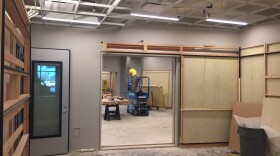Valley Public Radio’s new home isn’t just an impressive piece of architecture, it’s also opening up new doors for the station’s programming thanks to state-of-the-art broadcasting technology.
Unlike the station’s old home, the new building is designed from the ground up for digital broadcasting and data storage and delivery. Fiber optic lines allow for the station to receive programming from NPR and other producers over the internet, in addition to satellite delivery of programming. Over five miles of Cat-6 wiring serve both office data networks, VOIP phones, a separate broadcast data network, plus office WiFi (a first for VPR). The use of high capacity data wiring also allows for the station to adapt to future technology improvements, including proposed future fiber network that will connect NPR stations across the country.

Technology is at the core of the new building, literally. All tech operations in our new home are housed in one central room, allowing for ease of operation and maintenance. In our old building this equipment was spread out in four different areas, including janitorial closets, storage areas and inside the on-air studios. This created problems related to providing proper cooling for equipment, and noise from these machines was sometimes present on-air. The new facility allows us easy access to work on the equipment, and eliminates on-air noise by isolating the gear from our broadcast studios. The new technology center also is served by its own redundant air conditioning system. This ensures that all of our critical broadcast equipment, some of which can generate a lot of heat, will stay cool and functioning at an optimum temperature.
Another key element of the new facility the use of a technology called “Audio Over IP,” which uses internet protocols (IP) to send audio between devices and locations in the building. In our old facility all of our audio connections between different studios and equipment ran over fixed copper wire. If you wanted to add a new piece of equipment you had to add a new wire. If you wanted to change the destination of that audio, you had to change the wiring, which was a time consuming if not infeasible process. The satellite receivers could only be operated out of one studio. The recording equipment could only be operated out of another studio. Phone calls could only route to one location at a time. Now thanks to “Audio Over IP” all of that equipment is easily accessible in any studio in the building. And instead of fixed analog copper wiring that had to be run for each piece of new equipment, adding a new device is as simple as plugging in an internet cable.

This change has opened up new options for us in using our facility to produce the programming you hear. On Tuesday night June 7th for example, we produced 3 hours of local election night coverage. We configured the News Talk Control Room and talent studio for live broadcast. In the past this would have been a cumbersome process and would have required some of the on-air guests to be in different, non-adjacent rooms, since the old setup was not at all flexible.
And finally, technology has also helped to make us more efficient stewards of our natural resources. All of the lighting in the new building is energy efficient LED, daylight harvesting automatically adjusts artificial light to balance with the light coming in from the windows. Timers and motion sensors also ensure efficiency, as do automated controls for HVAC systems.




